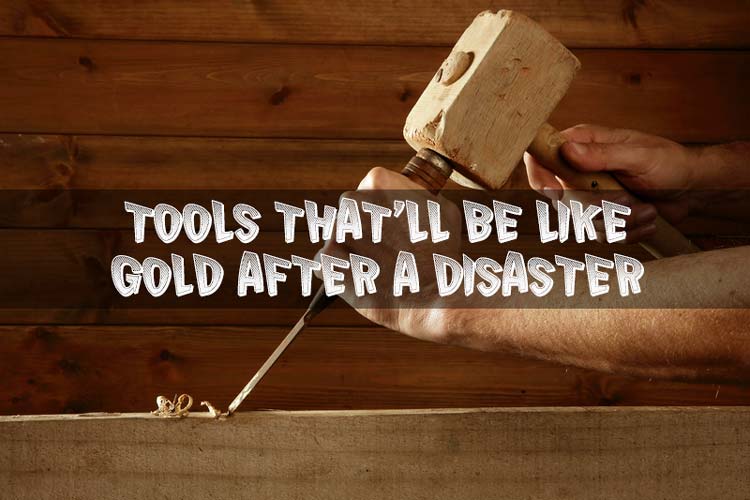Hope for the best, but plan for the worst.
You'll be glad to have hand tool alternatives on hand, especially if an EMP was involved, but even after a relatively mild catastrophe, say unexpected wide-scale flooding, severe weather conditions, or even civil unrest or martial law, you cannot depend on having electricity to spare for high-demand power tools. We're going to provide you with a list of what tools are the most important, but every situation is different, as is every region. Treat this as a starting point you can build on. Much of this stuff is not going to be easily portable – this isn't meant to be a bug-out-bag, this article is about planning to have the right tools to repair and re-build AFTER the stuff in your go-bag gets you through that initial rough part. If you're reading this, chances are a disaster scenario hasn't taken place yet, so now's the time to take stock, plan, then take action. Don't be one of those people racing to the hardware store, hoping it doesn't look like a more violent, desperate version of Black Friday.Your Immediate Aftermath Checklist:
Make a list of any gear or complex tools or machines you already keep on hand or at your shelter. This should include stuff that you know might not last you for a long-term disaster scenario, but that you figure will be really nice to have in the immediate aftermath. Think generators, lights, pumps, fans, and any communications gear. We'll get to the longer-term tools in a bit, but first make sure you know exactly where every key, special hex-wrench, fuel or air filter (plus extras), strap, handle, crank and cord that belongs with that aftermath gear is. Things may be moving fast when you discover the situation is bad and you don't want to be missing that one special little tool to let you unlock, deploy or adjust what you need to. Does your gear have instruction manuals you never read? Make sure they are close to whatever gear they belong to. No power, probably means no Internet to look that stuff up, remember. Turn this into a clear, easy-to-read checklist you can keep on paper with space for some notes. On Paper. Build the list using a PC or phone app if you like, but print it out and keep it somewhere easy to find because you should be checking this list on a routine basis. Ever lost the remote for your TV? Multiply that feeling by about a million when you go to refuel your emergency generator and the hose or the funnel or the filter is missing… or the fuel tank is empty. Want a use for your phone apps? Use any basic calendar/reminder feature on your computer or phone to help force you to run down that checklist every month or six months or whatever you figure it'll take to make sure no vital parts walked away, but keep that list on paper because it won't do you much good if the power is out and you just used the last bit of juice in your phone waiting on hold trying to find relatives lost in the emergency.On to the Main Tool List:
So you've survived the first few hours, then the first few days. Great! It was probably easier because you kept up your checklist routine, especially because of the practical side-effects: Knowing exactly where each part of your gear is, what needed replenished or replaced, charged up or readjusted ahead of time. Also, your aftermath checklist routine helps spot holes in your plans. You'll know what I mean the first time you have trouble getting something bought in summertime fired up during your routine test in winter months. Time to add a cover, container, or some kind of heater to whatever gizmo your checklist reminded you to fire up one chilly weekend! We'll cover the “Main Tool List” after the break (below). At this stage you'll gather the gear you'll need once some of the dust clears, post-disaster, for maintenance, repairs, and, most important, for manufacturing. This is where the real fun happens, where you'll plan a solid kit for the long-haul, but watch out. This is also the stuff that will make your gear – and you – the object of envy from others caught in a catastrophe:Pages: 1 2

Bob Peisley, Nick Greer
Republicans can’t use tools
It’s funny because I actually have quite a few of these and people laugh because I still use them occasionally to perfect their use
Seriously?
We use to worry about an EMP hitting the USA…any cheap $200,000 scud from a third-world would cripple us. Then my son said, “we have 9 major centers. If one is hit the others would automatically take-over their areas.” We saw this actually in Kansas when a tornado took out an energy power station, they re-routed electricity from another energy power plant and we never lost the food in our freezers. However, a underground connecting system connecting these would “insure” we would always have power for all our electronic devices. Living in hurricane and tornado areas, we always have provisions for a week…like the old scout motto: Always be prepared.
If this ever happened, there would be numerous thugs to take everything they wanted from you
Mike Myers
Chuck DeWitt
Have you ever seen a basement dwelling liberal build anything? A bong maybe.
I’ve seen a few scab conservative try but fail
You have too much time on your hands